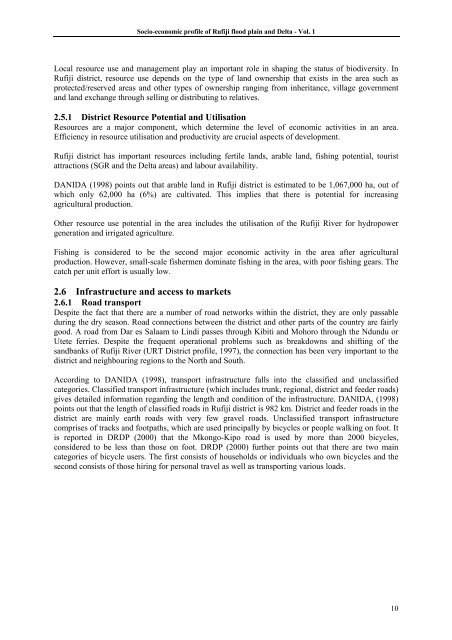A Socio-Economic Profile of the Rufiji Floodplain and Delta.
A Socio-Economic Profile of the Rufiji Floodplain and Delta.
A Socio-Economic Profile of the Rufiji Floodplain and Delta.
You also want an ePaper? Increase the reach of your titles
YUMPU automatically turns print PDFs into web optimized ePapers that Google loves.
<strong>Socio</strong>-economic pr<strong>of</strong>ile <strong>of</strong> <strong>Rufiji</strong> flood plain <strong>and</strong> <strong>Delta</strong> - Vol. 1<br />
Local resource use <strong>and</strong> management play an important role in shaping <strong>the</strong> status <strong>of</strong> biodiversity. In<br />
<strong>Rufiji</strong> district, resource use depends on <strong>the</strong> type <strong>of</strong> l<strong>and</strong> ownership that exists in <strong>the</strong> area such as<br />
protected/reserved areas <strong>and</strong> o<strong>the</strong>r types <strong>of</strong> ownership ranging from inheritance, village government<br />
<strong>and</strong> l<strong>and</strong> exchange through selling or distributing to relatives.<br />
2.5.1 District Resource Potential <strong>and</strong> Utilisation<br />
Resources are a major component, which determine <strong>the</strong> level <strong>of</strong> economic activities in an area.<br />
Efficiency in resource utilisation <strong>and</strong> productivity are crucial aspects <strong>of</strong> development.<br />
<strong>Rufiji</strong> district has important resources including fertile l<strong>and</strong>s, arable l<strong>and</strong>, fishing potential, tourist<br />
attractions (SGR <strong>and</strong> <strong>the</strong> <strong>Delta</strong> areas) <strong>and</strong> labour availability.<br />
DANIDA (1998) points out that arable l<strong>and</strong> in <strong>Rufiji</strong> district is estimated to be 1,067,000 ha, out <strong>of</strong><br />
which only 62,000 ha (6%) are cultivated. This implies that <strong>the</strong>re is potential for increasing<br />
agricultural production.<br />
O<strong>the</strong>r resource use potential in <strong>the</strong> area includes <strong>the</strong> utilisation <strong>of</strong> <strong>the</strong> <strong>Rufiji</strong> River for hydropower<br />
generation <strong>and</strong> irrigated agriculture.<br />
Fishing is considered to be <strong>the</strong> second major economic activity in <strong>the</strong> area after agricultural<br />
production. However, small-scale fishermen dominate fishing in <strong>the</strong> area, with poor fishing gears. The<br />
catch per unit effort is usually low.<br />
2.6 Infrastructure <strong>and</strong> access to markets<br />
2.6.1 Road transport<br />
Despite <strong>the</strong> fact that <strong>the</strong>re are a number <strong>of</strong> road networks within <strong>the</strong> district, <strong>the</strong>y are only passable<br />
during <strong>the</strong> dry season. Road connections between <strong>the</strong> district <strong>and</strong> o<strong>the</strong>r parts <strong>of</strong> <strong>the</strong> country are fairly<br />
good. A road from Dar es Salaam to Lindi passes through Kibiti <strong>and</strong> Mohoro through <strong>the</strong> Ndundu or<br />
Utete ferries. Despite <strong>the</strong> frequent operational problems such as breakdowns <strong>and</strong> shifting <strong>of</strong> <strong>the</strong><br />
s<strong>and</strong>banks <strong>of</strong> <strong>Rufiji</strong> River (URT District pr<strong>of</strong>ile, 1997), <strong>the</strong> connection has been very important to <strong>the</strong><br />
district <strong>and</strong> neighbouring regions to <strong>the</strong> North <strong>and</strong> South.<br />
According to DANIDA (1998), transport infrastructure falls into <strong>the</strong> classified <strong>and</strong> unclassified<br />
categories. Classified transport infrastructure (which includes trunk, regional, district <strong>and</strong> feeder roads)<br />
gives detailed information regarding <strong>the</strong> length <strong>and</strong> condition <strong>of</strong> <strong>the</strong> infrastructure. DANIDA, (1998)<br />
points out that <strong>the</strong> length <strong>of</strong> classified roads in <strong>Rufiji</strong> district is 982 km. District <strong>and</strong> feeder roads in <strong>the</strong><br />
district are mainly earth roads with very few gravel roads. Unclassified transport infrastructure<br />
comprises <strong>of</strong> tracks <strong>and</strong> footpaths, which are used principally by bicycles or people walking on foot. It<br />
is reported in DRDP (2000) that <strong>the</strong> Mkongo-Kipo road is used by more than 2000 bicycles,<br />
considered to be less than those on foot. DRDP (2000) fur<strong>the</strong>r points out that <strong>the</strong>re are two main<br />
categories <strong>of</strong> bicycle users. The first consists <strong>of</strong> households or individuals who own bicycles <strong>and</strong> <strong>the</strong><br />
second consists <strong>of</strong> those hiring for personal travel as well as transporting various loads.<br />
10
















